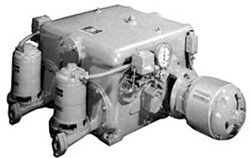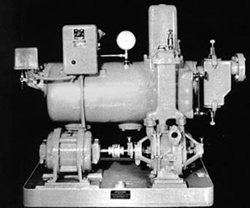 The main reasons for having vacuum pumps on low pressure steam condensate return lines are AIR REMOVAL and PRESSURE REDUCTION.
The main reasons for having vacuum pumps on low pressure steam condensate return lines are AIR REMOVAL and PRESSURE REDUCTION.
During mild weather when the boiler is on only part-time, the vacuum pump’s main job is to mechanically remove air from the system so we don’t have to use steam pressure to push air out.
This mechanical removal of air causes a smoother, more rapid system warm-up without the common start-up noises that would otherwise occur. Ideally, the vacuum pump should start a few minutes before the boiler’s cold start-up.
During cold weather when the boiler is always on, air removal is not much of a concern so the vacuum pump’s job now is pressure reduction; allowing the system to operate with the lowest possible steam pressure.
Let’s say for example the system is operating @ 7 PSI steam pressure and there is no vacuum on the return lines. This means we would have a 7 PSI pressure drop across the system.
For each 2″ Hg. vacuum on the return line, we would have 1 PSI negative or suction pressure. So, with a 10″ Hg. vacuum on the returns, we would have 5 PSI negative or suction pressure.
In this example, with this same 7PSI pressure drop across the system, and a 10″ Hg. vacuum on the return lines, our boiler could loaf along @ 2 PSI steam pressure, not 7. This allows us to use and make less steam and frequently results in a 20-30% saving in fuel costs.
IT IS A COMMON MISCONCEPTION THAT THE PURPOSE OF THE VACUUM PUMP IS TO DRAW THE CONDENSATE BACK TO THE RECEIVER. Condensate always flows back to the lowest point in the system by gravity.
Vacuum pumps can also be used to lift returning condensate; either from a low level auxiliary accumulator tank located right near the vacuum pump, or through special lift fittings out in the system. This is a secondary purpose of the vacuum pump and should not be considered as it’s only function.
In years past, it was common practice to use return line vacuum pumps on low pressure steam heating system. Today, we frequently see vacuum pumps abandoned in favor of pumps handling condensate only. Considering today’s fuel costs and the above information, it usually pays to consider the benefits of vacuum pumps on condensate return systems.
 Do Vacuum Pumps Really Make A Difference?
Do Vacuum Pumps Really Make A Difference?
A recent article* published jointly in ENGINEERED SYSTEMS and AIR CONDITIONING, HEATING, & REFRIGERATION NEWS magazines titled “NEGATIVE PRESSURE GIVES POSITIVE RESULTS” seems to indicate that they do.
This article describes the installation of 2 vacuum condensate return units at Church of St. Mary Schools in Manhasset, NY.
With previous gravity return condensate pumps, it was necessary to operate at 6 and 8 PSI steam pressure, operating 2 boilers. Boiler run times were 40 minutes per hour; taking 2 hours to get full steam distribution. Annual fuel costs for the 2 schools were reported to be $64,000.
After installation of the vacuum pumps, only one boiler was needed, OPERATING AT ONE QUARTER POUND STEAM PRESSURE, 1/4 PSI! Boiler run time was reduced to 18 minutes per hour; taking just 15 minutes to get full steam distribution. Return line vacuum was maintained at 8-10″ Hg.
Taking degree days into account, this increase in efficiency resulted in a reported drop in fuel consumption of 1200 gallons per month.
In years past, it was common practice to use return line vacuum pumps on low pressure steam heating systems. Today, we frequently see vacuum pumps abandoned in favor of pumps handling condensate only. Considering today’s fuel costs and the above information, it just might be worthwhile to take another look at vacuum pumps on condensate return systems. Fuel savings of 20-30% are frequently reported.
OAK SERVICES COMPANY specializes in the application of vacuum pumps for low pressure steam heating systems. We would welcome the opportunity to discuss the benefits of high capacity vacuum pumps applied to your system.
*To read the full article online, visit:
www.achrnews.com/articles/negative-pressure-gives-positive-results
More information about vacuum pumps available here:
www.heatinghelp.com/article/357/Vacuum-Steam-Systems/1516/A-bit-about-vacuum-pumps
